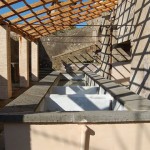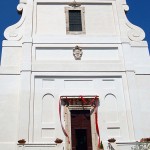In Renaissance period, the neighbourhood around modern via del Borgo was known as “lo spregiato” (the scornful), and in the Middle Ages it was the city ghetto.
In the archaeological area, today protected by fences, there was a Synagogue, later transformed into a hospital, just after the expulsion of the Jews from Palestrina at the time of Pope Pius V in 1568. The most of this area was destroyed by bombing in 1944.
The Sanctuary of Fortuna Primigenia had its access right on this street, where the complex was renovated and enlarged on a massive base made of polygonal limestone blocks by the end of the 2nd century B.C.
The tuff structures in Opus Quadratum, today visible beneath the basement, are part of an earlier phase of the sanctuary, followed by the reconstruction in the 2nd century B.C.
Just south of via del Borgo excavations have unearthed two terraces whose function was to link the lower Forum area to the upper Sanctuary area. On the superior terrace, immediately behind the fences, some fountains imitating natural caves (dating from the end of the 3rd century to the beginning of the 2nd century B.C., the oldest examples of the kind in Italy) have been found. The lower terrace, sustained by a wall in polygonal masonry, was decorated by another nymphaeum set inside an artificial cave, perhaps surrounded by a sacred wood.
The space between the Sanctuary of the Fortune in the upper city and the Forum in the lower was enliven by continuous waterworks.
.
 Archeopalestrina Percorso archeologico di Palestrina, l'antica Praeneste
Archeopalestrina Percorso archeologico di Palestrina, l'antica Praeneste





